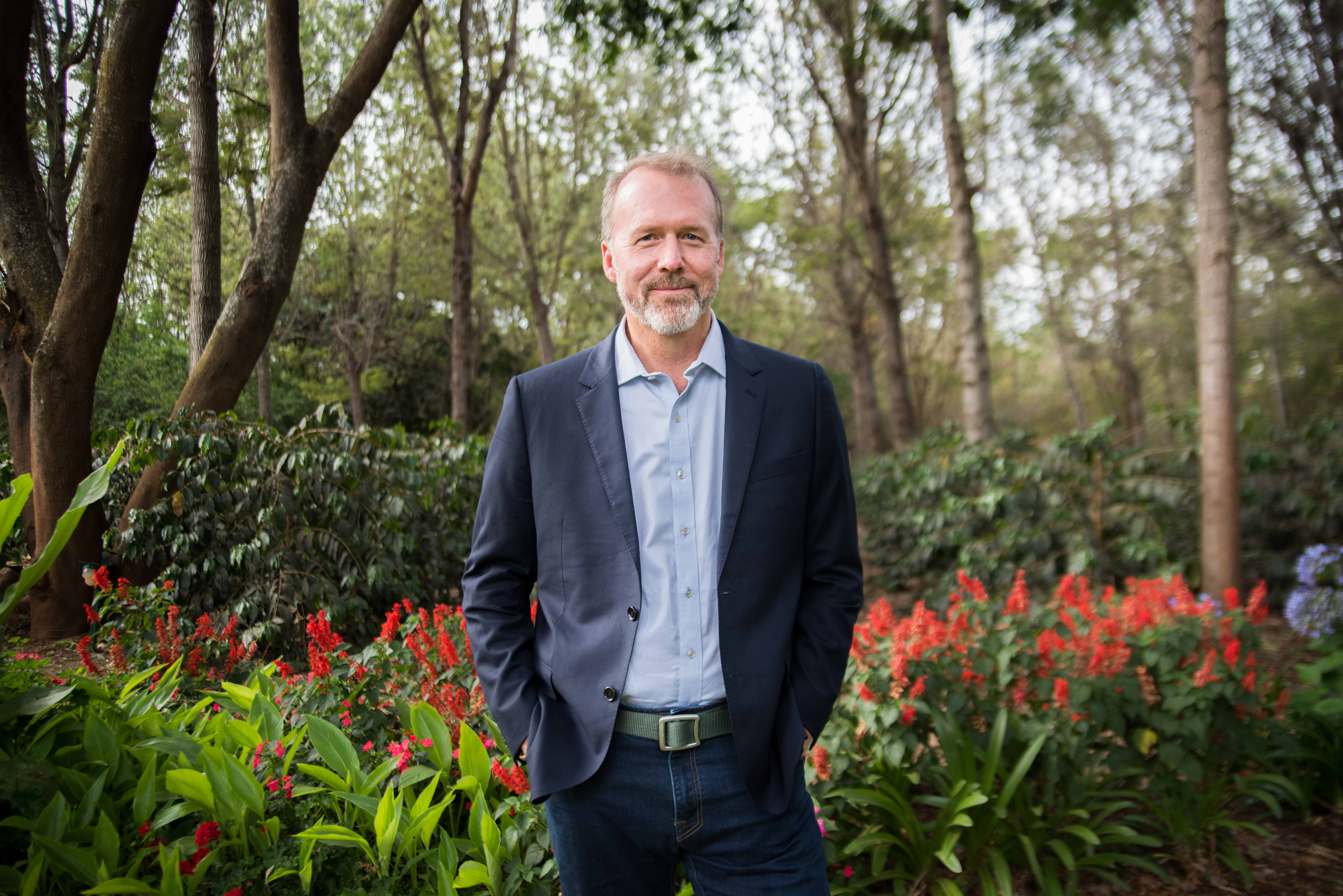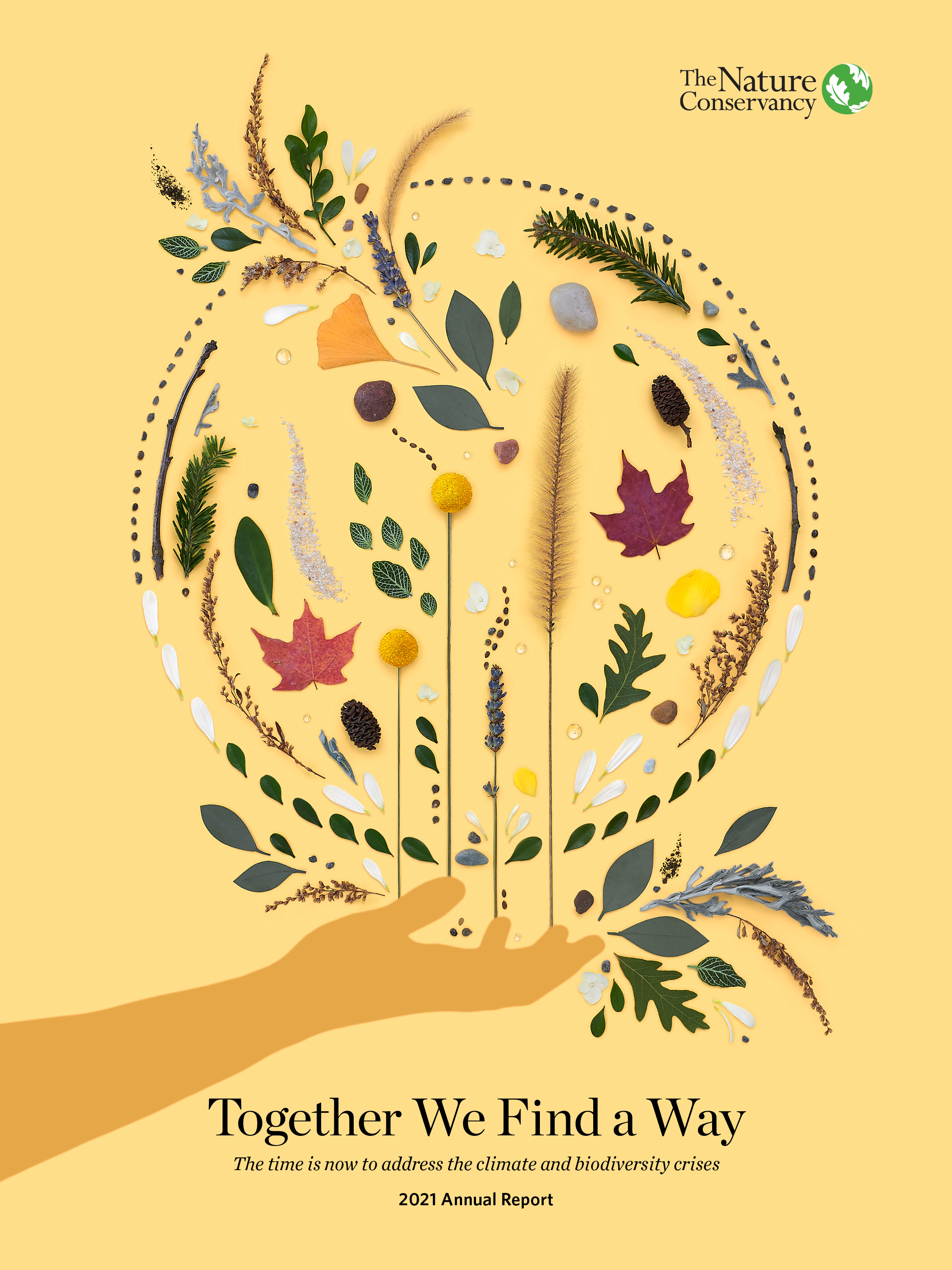
Together We Find A Way
The time is now to address the climate and biodiversity crises
2021 Annual Report
TNC 2021 Global Annual Report
View or download the entire report as a PDF:
PDF en Español | PDF in English | 简体中文PDF
From the CEO
Together We Will Find a Way
Something special started to take shape in 2021. As the stories and examples in this report show, the year brought with it an undeniable shift in the way many people have come to view the importance of nature as we race to confront the climate crisis and global biodiversity loss. As I met with leaders, experts and activists at November’s COP26 climate conference in Glasgow, Scotland, for example, the idea that nature can be a powerful force for climate solutions was at the center of the dialogue. This recognition is a huge accomplishment, and one that we need to accelerate if we are to avoid the worst of the looming ecological threats that scientists warn us about.
This is why we have been compelled to launch the boldest goals ever for The Nature Conservancy. Our six ambitious targets, which you’ll read about in this year’s report, will be our guide through 2030.
Our 2030 ambitions are huge, and, with the right strategies and enough resources, they are achievable. For more than 70 years, TNC has beat the odds to do critical conservation by working together with partners. And together is the key word here. As we take stock of where we are and where we want to go, we know that we can’t do it alone. We must deepen our collaboration with our peers in the NGO community, with governments and other major policy drivers as well as with corporate entities across the globe.
Looking ahead, I see three keys to transforming our ambitious goals into action:
First, we need to ensure broader participation. As we begin another year of this pivotal decade for nature, the conservation community must build a bigger tent. At The Nature Conservancy, we know we cannot address the biodiversity and climate crises without also elevating the leadership of the people who are best positioned to take action. This requires listening, learning and walking side by side with people from the communities where we work to understand their needs and to partner with local stakeholders. It also includes creating a more diverse workforce that is representative of the communities where we work. While we are early in our equity journey, we are committed to doing more and doing it better.
Next, we must do more to help drive smart, science- based policies. The recent climate and biodiversity commitments we’ve seen from governments and corporations give me hope, but we know that these commitments are only the first step. At TNC, we aren’t just pushing for our own conservation successes; we’re also working alongside governments, businesses and communities to turn policies and commitments into powerful action for nature.
Finally, we need to forge new paths to funding. Last year, we saw some good progress on this front: In Belize, for instance, we were able to help protect 236,000 acres of the Maya rainforest with funding in part from future carbon offsets, and we helped create a new financial mechanism that will reduce the country’s debt burden while generating significant funding for marine conservation. And at the COP26 conference, we saw almost 200 governments broker a global deal on carbon markets that could help generate new finance streams for forest and wetland protection, as well as transitions to clean energy. That said, there is still a long way to go to close the enormous funding gap needed to protect nature.
Our work to drive greater participation, policy and innovative funding in pursuit of a world where nature and people thrive is only possible thanks to our incredible community of partners, supporters and volunteer leaders around the globe. Every acre we protect, every river mile we restore, every tree we plant and ounce of carbon we help sequester from the atmosphere begins with you.
Thank you for being part of our efforts to build a brighter future for people and nature around the globe. The urgency for action and outcomes on critical issues is palpable, and I know that together, we will find a way.
Jennifer Morris
Chief Executive Officer, The Nature Conservancy
From the Chief Conservation Officer
TNC’s Conservation Plan to 2030
For 70 years, The Nature Conservancy has helped catalyze change around the world by working with diverse partners, embracing innovative collaborations and relentlessly pursuing solutions to the planet’s most pressing challenges.
The scale of the threats before us today are staggering. We are facing the interconnected crises of rapid climate change and biodiversity loss that threaten the future of life on our planet. During my 28 years of working for TNC, I have watched these crises rapidly materialize. Carbon dioxide levels in the atmosphere are now 50% higher than they were in preindustrial times, and human emissions have already increased the average temperature of the planet by about 1.1 degrees C (2 degrees F). The world has seen a nearly 70% decline in average species population sizes for birds, amphibians, mammals, fish and reptiles since 1970.
As we consider these global-scale problems and our role in shared global commitments like the Paris Climate Agreement, the U.N. Convention on Biological Diversity and the U.N. Sustainable Development Goals, we know this calls for our biggest, most ambitious plans yet. That is why we recently launched our new 2030 Goals, a set of urgent targets aimed at helping us secure a thriving planet this decade—for people and nature.
Our 2030 Goals will:
- Help 100 million people at severe risk of climate change become even more resilient through nature-based solutions
- Support the leadership of 45 million people whose lives depend on nature every day
- Save enough healthy land to cover India—twice
- Protect more than 10% of the world’s ocean and enough river kilometers to stretch around the globe 25 times
- Take 650 million cars’ worth of emissions out of the air every year
We know that these goals are ambitious—but we are also confident in our approach, which reflects decades of learning and partnership with communities and decision-makers around the world. This includes providing the science, tools and partnerships to help break through challenges; learning from and supporting Indigenous peoples and local communities as conservation leaders; working with governments, businesses and communities to scale solutions; and finding creative, innovative financial solutions to get results.
Our work is only possible thanks to my 4,000 colleagues, our more than 1 million members and supporters, and our partners around the globe. As we work toward our 2030 Goals, we walk confidently side by side knowing that together, we will find a way.
Our 2030 Goals
-

Avoid or sequester 3 billion metric tons of CO2 emissions annually
Using the power of nature and strength of policy and markets to store carbon, support the renewable energy build-out and reduce emissions equivalent to nearly 10% of global emissions from fossil fuels.
-

Help 100 million people at risk of climate-related emergencies
Protecting and restoring the health of natural habitats—from mangroves and reefs to floodplains and forests—that help protect communities from storm surge, extreme rainfall, severe wildfires and sea level rise.
-

Conserve 4 billion hectares of ocean
Making sure the oceans thrive through new and better-managed protected areas, global-scale sustainable fishing, innovative financing and positive policy changes to how the world governs the seas.
-

Conserve 650 million hectares of land
Partnering with communities across the globe to restore & improve management of working lands, support the leadership of Indigenous peoples as land stewards, & conserve critical forests, grasslands and other habitats rich in carbon & biodiversity.
-

Conserve 30M hectares of lakes & wetlands, 1M kilometers of river systems
Promoting innovative solutions and policies that improve the quality and amount of water available in freshwater ecosystems and to communities.
-

Support 45 million people, partnering with local and Indigenous communities
Partnering with Indigenous peoples and other communities to learn from and support their leadership in stewarding the environment, securing rights to resources, improving economic opportunities and shaping their future.
Highlights of our Conservation Work in 2021
Read excerpts from the report below to learn about our successful efforts to help protect the climate, oceans, freshwater, lands and people.
Climate
Protecting Nature and Building Livelihoods in Alaska’s Tongass
The lush Tongass temperate rainforest of Southeast Alaska brims with abundance, but that hasn’t led to a prosperous and enduring local economy. This ancestral territory of the Tlingit, Haida and Tsimshian people, who continue to care for the region’s land and waters, has been embroiled in generations of conflict over old- growth timber cutting and polluted salmon streams.
Divisions between major logging companies, fishing groups, Indigenous communities, the Forest Service and environmentalists have delayed progress toward the long-held hopes and dreams of local people.
Yet this year, Sealaska—an Alaska Native corporation and the region’s largest owner of private timber- lands—and the U.S. Department of Agriculture both announced an end to old-growth timber harvest.
The move is part of a larger shift toward supporting Indigenous communities and safeguarding salmon streams and the forest’s natural carbon-storing ability.
In addition, Sealaska launched a bold new idea. With a $10 million pledge, it challenged The Nature Conservancy to join it in establishing the Seacoast Trust—and TNC and partners met the challenge with a matching $10 million. Seacoast Trust is a permanent fund supporting an approach to conservation and eco-
nomics that understands communities are inseparable components of a healthy environment. The trust will finance ongoing efforts to manage forests and restore salmon streams, launch new entrepreneurial ventures, invest in youth and strengthen tribal authority.
“We are searching for economic and environmental balance that can come from a focus on collaboration, inclusive growth, social justice and Indigenous stewardship,” says Sealaska CEO Anthony Mallott.
The Seacoast Trust, with support from TNC and other partners, is continuing to work toward its $100 million goal to empower local people to keep their communities and environment alive and well.
Oceans
Growing Sustainable Seaweed Harvests in Zanzibar
Aquaculture is growing faster than any other sector of the global food system. And the evidence shows that when done right, in the right places, some types of aquaculture can actually help restore natural systems. Seaweed farms, for example, offer important nursery habitat for wild fish and may reduce local ocean acidification by soaking up carbon dioxide from the waters.
Seaweed has become a top export for Tanzania, thanks in large part to farmers in the waters around the coastal island of Zanzibar. This coastal aquaculture employs 25,000 farmers, 80% of whom are women.
Despite the national importance of seaweed aquaculture, in recent years seaweed farmers have faced setbacks caused by the declining quality of seed stocks and the local warming of water, resulting in smaller harvests.
Out of a mutual concern, TNC and a range of partners—including agri-business giant Cargill—have launched a training program to help seaweed farmers identify and implement more-sustainable farming techniques for their harvests. Nearly 200 farmers are now working together with help from the program to improve harvests and care for the environment.
“As the world faces ecological challenges too big for any one nation to overcome alone, we must work together to ensure that nature and peo ple can thrive everywhere,” says Lucy Magembe, TNC’s country director in Tanzania. “Seaweed is a reminder that a sustainable path is possible.”
Freshwater
Making Way for the Mississippi
Springtime floodwaters of the Mississippi River and its major tributaries were once free to spread out across broad, low-lying floodplains. In the 200 years since European settlement began, however, towns and farms have sprung up along rivers that are now hemmed in by thousands of miles of earthen embank ments called levees.
As climate change drives more destructive and unpredictable flooding throughout the Mississippi River Basin, many affected communities are rethinking how best to live with the river.
Atchison County, Missouri, is one such place. Following a devastating Missouri River flood in 2019, residents knew something had to change. The river flooded 56,000 acres, forcing evacuations and causing approximately $25 million in lost agricultural revenue. Even as the community recovered, residents knew floodwaters would return someday.
Local support coalesced around the idea of rebuilding a damaged levee farther back from the river, restoring nearly 1,100 acres of its natural floodplain. At the community’s request, TNC brought together a large group of partners to rebuild the levee in its new location and led the effort to purchase the land for conservation.
Atchison County’s experience with reconnecting the Missouri River with its floodplain—once unthinkable to many—has become a practical option for river communities. The Conservancy is continuing to work with communities to restore and reconnect 750,000 acres of river floodplains.
Lands
TNC Helps Protect 236,000 Acres of Belize’s Maya Rainforest
Where would you go to see a wild jaguar? Try the Maya Forest in Belize, where this past April, The Nature Conservancy and partners announced the closing of a $76.5 million deal to protect 236,000 acres of the largest remaining tropical rainforest in the Americas north of the Amazon. The new Belize Maya Forest preserve connects an 11-million-acre network of protected land across Belize, Mexico and Guatemala—an area roughly the size of Vermont and New Hampshire combined. The network now protects more than a quarter of the entire carbon-rich Selva Maya forest, which is home to Central America’s largest remaining populations of jaguars, pumas and other increasingly threatened native cat species.
The region faces growing threats from industrial agriculture and illegal logging. Now, the expanded conservation network is creating economic opportunities such as ecotourism and the sale of carbon credits—incentives for protecting threatened habitats and extensive Maya cultural sites.
A coalition of more than a dozen groups worked for years to conserve the area, including the Programme for Belize, the University of Belize Environmental Research Institute, the Bobolink Foundation, the Rainforest Trust, The Wyss Foundation and TNC. The newly formed Belize Maya Forest Trust, directed by Dr. Elma Kay, a Belizean scientist, is leading the preserve’s long-term management. Because the forest likely would have been cleared for agriculture if it hadn’t been protected, the Belize government agreed to support the sale of carbon credits from the new preserve, which will fund half the land purchase and establish a $15 million stewardship endowment.
People
Growing Healthy Pasturelands in Nicaragua
Every year, farmers at work under Nicaragua’s tropical sky watch for the promise of abundant rains in the month of May. But if the rains are late or fail altogether, drought compounds the pressures of the dry season, diminishing harvests and milk production on family dairy farms.
In response, The Nature Conservancy teamed up with LALA Group, the region’s largest dairy company, to make farms more sustainable by providing farmers with technical and financial assistance to transform typical small-plot grass pastures with plantings of diverse shrubs and trees. The mix offers shade, restores water sources, locks in soil nutrients, supports biodiversity and ensures a longer grazing season. It also means more volume and higher-quality milk—and better incomes.
This Resilient Central America project, administered by TNC through funding from the U.S. Department of State and with expertise from TechnoServe and LALA, has introduced these agroforestry pasture systems on 36 model farms and trained 700 farmers. And what has proved successful in the Nicaragua countryside is now reaching farms in Mexico and elsewhere in Central America.
Financial Overview for Fiscal Year 2021
Letter From the Chief Finance and Administrative Officer
In fiscal year 2021, we entered our first full year of operating in the midst of the COVID-19 global pandemic, and we adjusted our operations and tactics in anticipation of a possibly sizable decline in revenue. However, a combination of factors—economic stimuli by governments around the world, a sharp rebound in financial market performance, and the continuing commitment and generosity of our supporters—helped make it our most successful financial year on record as a revenue matter. We also saw our 11th consecutive year of improvement in the strength of our balance sheet, which positions us to aggressively tackle our ambitious new 2030 Goals.
During this challenging year, the priority focus of our management team was twofold.
First, the pandemic required undertaking work differently and more creatively, such as collaborating primarily over video conferences rather than in person. A critical priority was tending to the safety and well-being of our staff to ensure that we could continue to advance our mission. We dedicated significant energy to enabling our staff, supporters and conservation partners to engage virtually, and to providing new tools, equipment and business processes to staff, allowing them to safely, securely and effectively conduct business remotely.
Second, we completed the articulation of our 2030 Goals—a long-term vision for the ambitious but essential work we must do over the next decade to protect biodiversity and reduce the impacts of climate change in collaboration with partners around the globe. We focused our efforts and resources on accelerating our conservation plans, enabled by leading-edge financial, information technology, and investment management tools and strategies.
In total, financial results achieved during the last year outperformed our initial expectations and, as such, allowed for an increase in spending on conservation activities, despite prudent budgetary contractions planned in response to the pandemic. The increase in conservation activities was offset by a somewhat smaller amount of spending on conservation land purchases, which varies from year to year.
Fundraising from private donors reached a record high, buoyed by a gift of $100 million from the Bezos Earth Fund to support climate outcomes across multiple continents. Private donor support increased across all major segments, and we are grateful for the generosity expressed by so many of our supporters, whether by joining us for virtual visits and trips rather than in person, or by expanding the flexibility of their gifts to accommodate our unusual operating circumstances. Investment income was the organization’s largest driver of revenue growth, reflecting a buoyant equity market and active management decisions by our team of in- vestment professionals. In the year ahead, The Nature Conservancy will continue to accelerate the pace of investment in our ambitious 2030 conservation goals, and to build an even stronger foundation of operational excellence to support our work. We are, as always, grateful to our donors, collaborators and supporters for their partnership in protecting nature’s biodiversity and strengthening its resilience in the face of a changing climate during this critical decade for the planet.
Financial Summary
For the fiscal years ending on June 30, 2021 & 2020 (in thousands)
Note: The figures that appear in the financial summary shown are derived from the 2021 & 2020 consolidated financial statements that have been audited and have received an unqualified opinion.
| 2021 | 2020 | |
|---|---|---|
| Dues and private contributions | 849,330 | 783,245 |
| Government contributions | 104,790 | 126,423 |
| Total Dues & Contributions | 954,120 | 909,668 |
| Investment income | 614,989 | 78,252 |
| Other income | 159,486 | 93,178 |
| Land sales and gifts | 97,070 | 148,943 |
| Total Support & Revenue | 1,825,665 | 1,230,041 |
| 2021 | 2020 | 2021* | 2020* | |
|---|---|---|---|---|
| Conservation activities and actions | 546,505 | 536,341 | 59.6% | 53.0% |
| Purchases of conservation land and easements | 87,646 | 156,210 | 9.6% | 15.4% |
| Total Conservation Program Expenses & Purchases of Conservation Land & Easements | 634,151 | 692,551 | 69.2% | 68.5% |
| General and administrative | 160,199 | 180,679 | 17.5% | 17.9% |
| Fundraising and membership | 122,519 | 138,127 | 13.3% | 13.7% |
| Total Support Services | 282,718 | 318,806 | ||
| Total Expenses & Purchases of Conservation Land & Easements | 916,869 | 1,011,357 | ||
| Net Result—Support & Revenue Over Expenses & Purchases of Conservation Land & Easements1 | 908,796 | 218,684 |
* % of each dollar spent
| 2021 | 2020 | |
|---|---|---|
| Conservation lands | 2,171,166 | 2,150,851 |
| Conservation easements | 2,415,002 | 2,386,747 |
| Investments held for conservation projects | 1,311,605 | 941,950 |
| Endowment investments | 1,653,060 | 1,334,391 |
| Planned-giving investments | 395,421 | 315,736 |
| Property & equipment (net of depreciation) | 151,504 | 152,334 |
| Other assets 2 | 738,458 | 588,371 |
| Total Assets | 8,836,216 | 7,870,380 |
| Accounts payable and accrued liabilities | 144,021 | 145,425 |
| Notes payable | 305,522 | 338,123 |
| Other liabilities 3 | 497,412 | 420,291 |
| Total net assets | 7,889,261 | 6,966,541 |
| Total Liabilities & Net Assets | 8,836,216 | 7,870,380 |








